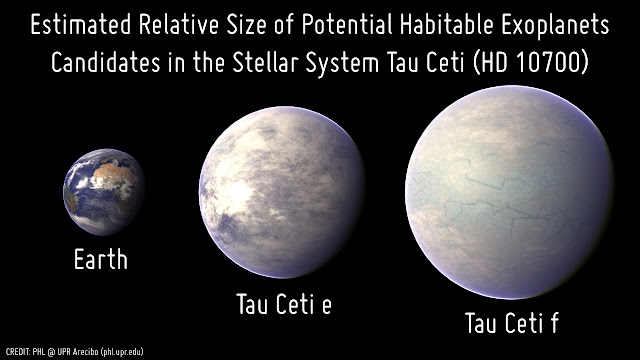| An international team of astronomers has discovered that Tau Ceti, the closest single star like our Sun, has planets just like our solar system. But more importantly, one of these planets orbits in the so-called habitable zone around the star. Moreover, at only 12 light years away, Tau Ceti is relatively very close to Earth. |
At a distance of twelve light years from Earth and visible to the naked eye in the evening sky, Tau Ceti is the closest single star that has the same spectral classification as our Sun. Its five exoplanets are estimated to have masses between two and six times the mass of the Earth, making it the lowest-mass planetary system yet detected. One of the planets lies in the habitable zone of the star and has a mass around five times that of Earth, making it the smallest planet found to be orbiting in the habitable zone of any Sun-like star.
The team presented its findings in a paper that has been accepted for publication in Astronomy & Astrophysics.
The international team of astronomers from the United Kingdom, Chile, United States, and Australia, combined more than six-thousand observations from three different instruments and intensively modeled the data. Using new techniques, the team has found a method to detect signals half the size previously thought possible. This greatly improves the sensitivity of searches for small planets and suggests that Tau Ceti is not a lone star but has a planetary system.
"This discovery is in keeping with our emerging view that virtually every star has planets, and that the galaxy must have many such potentially habitable Earth-sized planets," said coauthor Steve Vogt, a professor of astronomy and astrophysics at UC Santa Cruz.
"We are now beginning to understand that nature seems to overwhelmingly prefer systems that have multiple planets with orbits of less than 100 days. This is quite unlike our own solar system, where there is nothing with an orbit inside that of Mercury. So our solar system is, in some sense, a bit of a freak and not the most typical kind of system that Nature cooks up."
First author Mikko Tuomi of the University of Hertfordshire emphasized the importance of new techniques the team developed. "We pioneered new data modeling techniques by adding artificial signals to the data and testing our recovery of the signals with a variety of different approaches," Tuomi said. "This significantly improved our noise modeling techniques and increased our ability to find low-mass planets."
Hugh Jones, also at the University of Hertfordshire, said the researchers chose Tau Ceti for this noise-modeling study because they had thought it contained no signals. "As it is so bright and similar to our Sun, it is an ideal benchmark system to test out our methods for the detection of small planets," Jones said.
SOURCE University of California, Santa Cruz, Images: Planetary Habitability Laboratory
| By 33rd Square | Subscribe to 33rd Square |





0 comments:
Post a Comment